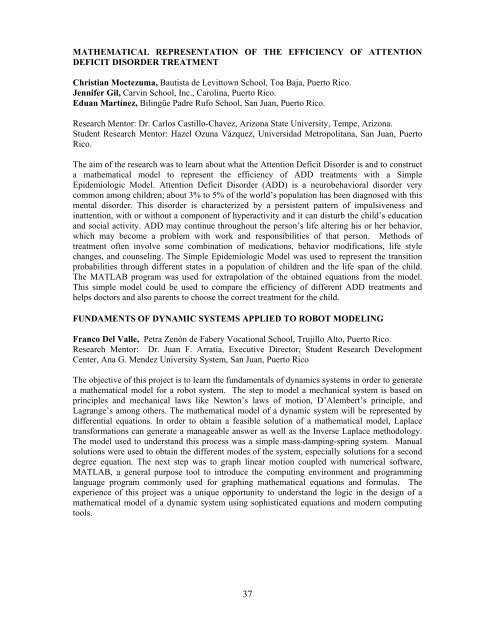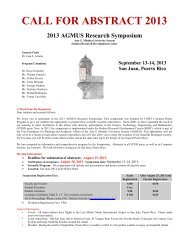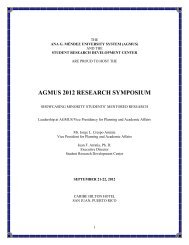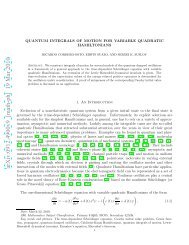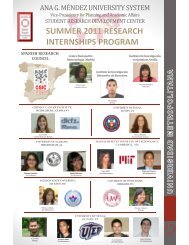WINTER 2008 PRE-COLLEGE RESEARCH SYMPOSIUM - Student ...
WINTER 2008 PRE-COLLEGE RESEARCH SYMPOSIUM - Student ...
WINTER 2008 PRE-COLLEGE RESEARCH SYMPOSIUM - Student ...
You also want an ePaper? Increase the reach of your titles
YUMPU automatically turns print PDFs into web optimized ePapers that Google loves.
MATHEMATICAL RE<strong>PRE</strong>SENTATION OF THE EFFICIENCY OF ATTENTION<br />
DEFICIT DISORDER TREATMENT<br />
Christian Moctezuma, Bautista de Levittown School, Toa Baja, Puerto Rico.<br />
Jennifer Gil, Carvin School, Inc., Carolina, Puerto Rico.<br />
Eduan Martínez, Bilingüe Padre Rufo School, San Juan, Puerto Rico.<br />
Research Mentor: Dr. Carlos Castillo-Chavez, Arizona State University, Tempe, Arizona.<br />
<strong>Student</strong> Research Mentor: Hazel Ozuna Vázquez, Universidad Metropolitana, San Juan, Puerto<br />
Rico.<br />
The aim of the research was to learn about what the Attention Deficit Disorder is and to construct<br />
a mathematical model to represent the efficiency of ADD treatments with a Simple<br />
Epidemiologic Model. Attention Deficit Disorder (ADD) is a neurobehavioral disorder very<br />
common among children; about 3% to 5% of the world’s population has been diagnosed with this<br />
mental disorder. This disorder is characterized by a persistent pattern of impulsiveness and<br />
inattention, with or without a component of hyperactivity and it can disturb the child’s education<br />
and social activity. ADD may continue throughout the person’s life altering his or her behavior,<br />
which may become a problem with work and responsibilities of that person. Methods of<br />
treatment often involve some combination of medications, behavior modifications, life style<br />
changes, and counseling. The Simple Epidemiologic Model was used to represent the transition<br />
probabilities through different states in a population of children and the life span of the child.<br />
The MATLAB program was used for extrapolation of the obtained equations from the model.<br />
This simple model could be used to compare the efficiency of different ADD treatments and<br />
helps doctors and also parents to choose the correct treatment for the child.<br />
FUNDAMENTS OF DYNAMIC SYSTEMS APPLIED TO ROBOT MODELING<br />
Franco Del Valle, Petra Zenón de Fabery Vocational School, Trujillo Alto, Puerto Rico.<br />
Research Mentor: Dr. Juan F. Arratia, Executive Director, <strong>Student</strong> Research Development<br />
Center, Ana G. Mendez University System, San Juan, Puerto Rico<br />
The objective of this project is to learn the fundamentals of dynamics systems in order to generate<br />
a mathematical model for a robot system. The step to model a mechanical system is based on<br />
principles and mechanical laws like Newton’s laws of motion, D’Alembert’s principle, and<br />
Lagrange’s among others. The mathematical model of a dynamic system will be represented by<br />
differential equations. In order to obtain a feasible solution of a mathematical model, Laplace<br />
transformations can generate a manageable answer as well as the Inverse Laplace methodology.<br />
The model used to understand this process was a simple mass-damping-spring system. Manual<br />
solutions were used to obtain the different modes of the system, especially solutions for a second<br />
degree equation. The next step was to graph linear motion coupled with numerical software,<br />
MATLAB, a general purpose tool to introduce the computing environment and programming<br />
language program commonly used for graphing mathematical equations and formulas. The<br />
experience of this project was a unique opportunity to understand the logic in the design of a<br />
mathematical model of a dynamic system using sophisticated equations and modern computing<br />
tools.<br />
37


